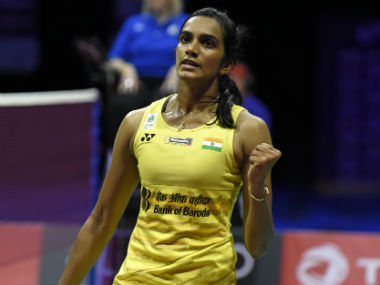If you look at the names of the rivals in the women’s singles finals of the two most important tournaments in each of the last two years, there is just one name that runs like a common thread in three out of four summit clashes. India’s PV Sindhu was in the finals of the 2016 Rio Olympics, narrowly missed making the title round of the year-ending Dubai World Superseries 2016 finals, but was there in the finals of the 2017 World Championships and the 2017 Dubai World Superseries Finals. Even in the 2016 Dubai Finals, Sindhu was present in the final mix — she lost narrowly in three games to South Korea’s Sung Ji Hyun in the penultimate round, after clearing the group stage comfortably with two victories and a solitary defeat. No other player featured in even two of these finals; it was Carolina Marin at the Olympics, Taiwan’s Tai Tzu Ying and South Korea’s Sung Ji Hyun in Dubai 2016, Japan’s Nozomi Okuhara in the 2017 Worlds and Akane Yamaguchi in 2017 Dubai Superseries Finals. [caption id=“attachment_4180891” align=“alignleft” width=“380”] File image of PV Sindhu. AP[/caption] One must also underscore the fact that Sindhu had an exceptional year, winning the India and Korea Open Superseries titles, and being the runner-up to Tai in the Hong Kong Open. When clubbed with the fact that she has won medals in three of the last four World Championships — silver in 2017, and bronze in 2013 and 2014 — it can be seen that she is right up there with the best. She missed out only in 2015, when compatriot Saina Nehwal took silver behind Marin’s gold. Now, if that is not consistency, what is? But the primary attribute of this consistency is the fact that the Hyderabadi has been ending up on the losing side in every one of the gold medal matches, and has had to end up with silver. Sindhu lost the Olympic final to Spaniard Marin, the World championship final earlier this year to Japan’s Okuhara and the Dubai Superseries final to another Japanese, Yamaguchi. And all, by slim margins in the third and deciding games — 15-21 in Rio, 20-22 in Glasgow and 19-21 in Dubai. Both Okuhara (22) and Yamaguchi (20), two of the fittest women on the international circuit, played a game of attrition against Sindhu, engaging her in lengthy, energy-sapping rallies and bottling up her smash with deep, flat clears to the baseline corners, followed up with crosscourt net-hugging drops. In both these matches, the 22-year-old Indian demonstrated not just a willingness to remain patient, but also the ability to push her long, lean body beyond its limits while playing those interminable rallies. Sindhu would be bent over in the shape of an inverted ‘U’, trying desperately to get the air back into her lungs, but when the next rally began, she would continue to cover the court with the same agility she had displayed right through the encounter. It was a display worthy of admiration, for she was suffering from a bad cold in Dubai, and had difficulty breathing after the lengthy rallies. Where Sindhu perhaps lost out was in the mental department; she has been consistently having trouble closing out matches, and that malady returned to haunt her when she made two simple, unforced errors against Yamaguchi at 19-all. Her excuse was that her racket strings had snapped at 18-19, and the changed racket had a slightly different feel in her hand. It is possible that this flaw in her game will get ironed out automatically when her fitness level improves just a little bit more, and match those of the two diminutive Japanese girls. If it does not, then her coach, Pullela Gopichand, will need to employ the services of a psychologist to get her mental conditioning right. For, make no mistake, Sindhu is an exceptional talent, and stands on the threshold of greatness. “To succeed, it is very important to put your last loss behind you and move on quickly,” Gopichand says with great wisdom. “You cannot allow a player to get down or think too much about what went wrong, or what didn’t work to plan. Staying fresh mentally is critical. As a coach, I have to help a player move on from a loss. “In all the tournaments that Sindhu will play in the foreseeable future, I have to keep her motivation up and help her move on from defeat. Such defeats can have a deep impact on a player’s mindset. We have a huge year ahead, with the Commonwealth Games, Asian Games, a dozen Superseries tournaments, now called the World Tour, the Indian Grand Prix and finally, the year-ending World Tour Finals. Players need to remain focused on what lies ahead.”
Indeed, they do need to maintain their focus, for the women’s circuit has become enormously competitive, to the extent that any one of the top ten women can beat any of the others on a given day.
Perhaps the only one to have claimed an aura of invincibility for at least part of the year was Chinese Taipei’s Tai Tzu Ying, who had a phenomenal run in the first quarter of the year, winning five tournaments, including the All England and Malaysia Opens, and going 30 matches without a defeat, if one were to include her title run at the 2016 Dubai World Finals. Tai, who won in Singapore, France and Hong Kong as well, had by far the most successful year among the women, but chose to skip the World Championships in favour of the University Games in her home town of Taipei, and suffered two year-end defeats at the hands of Thailand’s 2013 world champion, Ratchanok Intanon, in the Denmark Open Superseries and the Dubai World Finals. In fact, Intanon was the only one to understand and unravel the secrets of Tai’s deceptive game; no other woman on the circuit could do that. Not Sindhu, who trails the Taiwanese 3-8 in career meetings, nor even Yamaguchi, who has lost four of her last six meetings with Tai. Nor even erstwhile World No 1, Saina, who has been beaten in her last half-dozen encounters with the Taiwanese, including three matches in straight games. Contiguous with the slow fade-out of Tai in the closing months of 2017 was the fabulous year-end gallop put in by Yamaguchi, who bagged the China Open Superseries Premier and the Dubai World Finals, although in the interim period, she was well beaten in Hong Kong by Sindhu. The Japanese powerhouse made up for the absence of compatriot Okuhara, who remained injured through the closing stages of the season, and could not even take her place in the Dubai Finals. Badminton aficionados were delighted to witness the return to full fitness and form of Intanon, whose delightful strokeplay had been unable to mask her lack of fitness in the last couple of years. She had the Denmark Open Superseries Premier title to show for her efforts, and remained a threat to all the other top-notchers throughout a year that saw a gentle fade-out of the two-time world champion and Olympic gold medallist, Carolina Marin, due mostly to one injury or another. Yet another player to make waves on the international scene was junior world champion Chen Yufei who, along with left-hander He Bingjiao, has been identified by the mandarins as the future of Chinese badminton after the tall Sun Yu appears to have been discarded. At 19 years of age, Chen is an outstanding player; and it would surprise no one if she were to bag the world championship in a couple of years’ time. As for Saina, it was wonderful to see her back to near-full fitness after the knee injury, sustained during the Rio Olympics in August 2016 had threatened to call a halt to her long career. Nevertheless, the Haryana-born, Hyderabad-domiciled player could not leave her own impression on the world circuit, and failed to win any of the tournaments in which she participated. Still, there was one moment of intense satisfaction for the 27-year-old Saina when she captured the Nationals title for the third time in her career, in just as many attempts, at the expense of Sindhu. The fact that she eclipsed in straight games the player who bids fair to take over her mantle as India’s premier shuttler was the icing on the cake.


)




